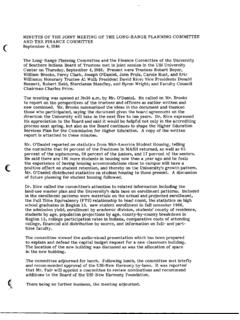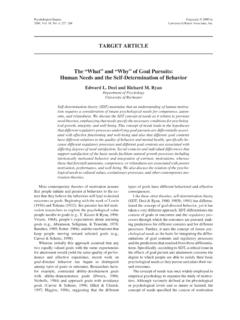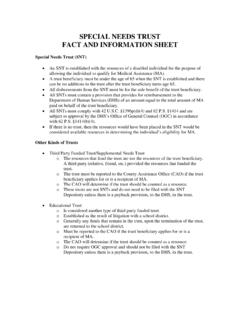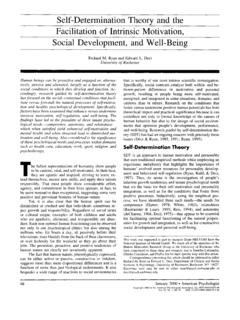Transcription of ANIMAL ADAPTATIONS
1 Self-Directed Tour Grades Three through Five ANIMAL ADAPTATIONS . Teacher Guide This self-guided tour will introduce you and your class to animals at the Milwaukee County Zoo, and focus on their ADAPTATIONS for survival. Animals live in a variety of unique environments. To survive in many of these environments, animals have adapted both behaviorally and physically. At the Zoo, you can observe some of the special physical ADAPTATIONS that animals have developed over the ages. In this tour, you will be introduced to the world of ANIMAL ADAPTATIONS , including what ADAPTATIONS are, why some ADAPTATIONS benefit an ANIMAL , and which animals typify certain ADAPTATIONS .
2 Table of contents Objectives and vocabulary Section 1. Adaptation information Section 2. Zoo ANIMAL information Section 3. Pre-visit activities Section 4. Zoo visit activities Section 5. Post-visit activities Section 6. Zoo map Back page This curriculum packet has been provided by the Zoological Society of Milwaukee County and the Ladish Company Foundation. Section 1. Objectives o Children will understand what ANIMAL ADAPTATIONS are. o Children will be able to explain why ANIMAL ADAPTATIONS are important. o Children will be able to explain different types of ANIMAL ADAPTATIONS and how they serve different animals. ANIMAL ADAPTATIONS -- Vocabulary Adaptation A body part, body covering, or behavior that helps an ANIMAL survive in its environment.
3 Behavior The actions of an ANIMAL . Camouflage A color or shape in an ANIMAL 's body covering that helps it blend into its environment. Environment Everything that surrounds and affects a living thing. The environment includes non-living things, such as water and air, as well as other living things. Habitat The place where an ANIMAL lives. The physical characteristics of an ANIMAL 's surroundings. Inborn Behavior (instinct). A behavior an ANIMAL is born with and does not have to learn. Mimicry An adaptation in which an otherwise harmless ANIMAL looks like a harmful ANIMAL in order to protect itself. Predator An ANIMAL that hunts and eats other animals for food.
4 Prey An ANIMAL that is taken and eaten by another ANIMAL (predator) for food. Survive/Survival Using ADAPTATIONS to continue to live. Section 2. ADAPTATIONS ADAPTATIONS are any behavioral or physical characteristics of an ANIMAL that help it to survive in its environment. These characteristics fall into three main categories: body parts, body coverings, and behaviors. Any or all of these types of ADAPTATIONS play a critical role in the survival of an ANIMAL . ADAPTATIONS can be either physical or behavioral. A physical adaptation is some type of structural modification made to a part of the body. A behavioral adaptation is something an ANIMAL does - how it acts - usually in response to some type of external stimulus.
5 When you look at an ANIMAL , you usually can see some of its ADAPTATIONS -- like what it is able to eat, how it moves, or how it may protect itself. Different animals have many different ways of trying to stay alive. Their ADAPTATIONS are matched to their way of surviving. Each group of animals has its own general ADAPTATIONS . These groups are: fish, amphibians, reptiles, birds, and mammals. Some of these ADAPTATIONS make it easy to identify which group an ANIMAL belongs to. A good example of an ANIMAL adaptation is the way in which an ANIMAL moves from one place to another. Animals have evolved their ADAPTATIONS . This means a long period of slow change resulted in an ANIMAL 's adaptation(s).
6 The spots on the snow leopard, for example, did not emerge overnight. Instead, this process took generation upon generation of snow leopards physically adapting to their environment for characteristic spot patterns to evolve. Those snow leopards with spot patterns were able to hide more successfully, therefore surviving longer than those without spots. This allowed the longer surviving snow leopards to reproduce and create more snow leopards with spot patterns like their own. Indeed, this process of change over time is the key to how many organisms develop ADAPTATIONS . Some ADAPTATIONS can arise quickly through genetic mutations; these mutations also may be deadly.
7 In the sections that follow, different types of distinctly visible ADAPTATIONS and their importance will be discussed. Since behavioral ADAPTATIONS are far more difficult to observe, these will not be discussed. However, the visible ADAPTATIONS mentioned are easy to recognize on most animals at the Zoo and should be of special interest to children. Body Parts Many animals have developed specific parts of the body adapted to survival in a certain environment. Among them are webbed feet, sharp claws, whiskers, sharp teeth, large beaks, wings, and hooves. Webbed Feet In most aquatic animals, swimming is a must. To aid swimming, many animals have adapted and evolved with webbed feet.
8 Webbed feet help animals propel themselves through the water with ease. This can help the ANIMAL swim faster to catch prey or escape a predator. Also, if an ANIMAL has to swim long distances, webbed feet can help it save energy so it can swim farther. One ANIMAL that can be observed at the Zoo with webbed feet is the rockhopper penguin. Other animals with slightly webbed feet: the polar bear and otter. Sharp Claws Many land and sea animals alike have developed sharp claws. Sharp claws can be used for many different purposes. For instance, many herbivores use their sharp claws for digging for berries, roots, and herbs or burrowing for shelter.
9 Animals that eat meat may use their claws for killing their prey or tearing meat from their kills. Also, claws can be used to increase traction to run faster, as in the case of the cheetah. Other times, sharp claws have evolved for use in defense. For some animals, showing of claws is enough warning for their predators or competitors to back off. There are many animals at the Milwaukee County Zoo with sharp claws, including many of the bears and felines, as well as aquatic animals like the California sea lion. Whiskers Although not usually thought of as an adaptation, whiskers serve an important purpose for many animals. In most cases, whiskers around the face, specifically the mouth area, help the ANIMAL feel its way through tight spots.
10 In a way, they serve as "feelers," telling the ANIMAL whether or not it can fit into a specific area. One example is that of the North American river otter, which can use its whiskers both on land and in water. On land, they are used to feel their way through narrow channels, with a similar purpose for the whiskers under water. They are also useful to sense prey. Sharp Teeth One of the most visible ADAPTATIONS on many animals, sharp teeth help an ANIMAL eat meat. Found primarily on meat-eating animals, or carnivores, sharp teeth are used mainly for the tearing and chewing of an ANIMAL 's prey. Rather than developing the dull teeth of plant-eaters, or herbivores, carnivores rely on their sharp teeth to allow them to eat and survive.



















